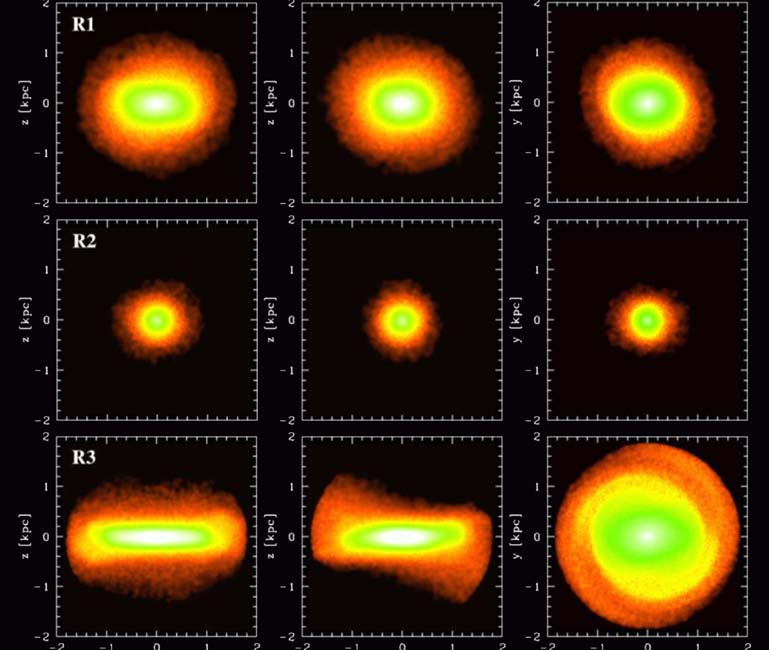left: Kazantzidis used Ohio Supercomputer Center systems to compile these three-panel surface density maps from three different simulations of the final stellar configurations of dwarf galaxies.
Supercomputing centers allow astronomers to create extremely sophisticated models that are not feasible to build on desktop systems. However, simulating the multitude of elements involved in these galactic processes remains an enormous challenge.
“Our models can follow only a small subset of, say, the stars in a galaxy,” explained Stelios Kazantzidis, Ph.D., a long-term fellow at Ohio State's Center for Cosmology and Astro-Particle Physics. “For example, a galaxy like our Milky Way contains hundreds of billions of stars, and even the most sophisticated numerical simulations to date can simulate only a tiny fraction of this number. The situation becomes increasingly more difficult in simulations that involve dark matter. This is because the dark-matter particle is an elementary particle and, therefore, it is much less massive than a star.”
Leveraging Ohio Supercomputer Center resources, Kazantzidis' research teams simulated disk galaxies merging with supermassive black holes (SMBH). They found the mass ratios of SMBH pairs in merged-galaxy centers do not necessarily relate directly to the ratios they had to their original host galaxies, but are “a consequence of the complex interplay between accretion of matter onto them and the dynamics of the merger process.” As a result, one of the two SMBHs can grow in mass much faster than the other.
Kazantzidis believes simulations of the formation of binary SMBHs have the potential to open a new window into astrophysical and physical phenomena that cannot be studied in other ways and might help to verify general relativity, one of the most fundamental theories of physics.
Kazantzidis and his colleagues also developed sophisticated computer models to simulate the formation of dwarf spheroidal galaxies, which are satellites of the Milky Way. The study concluded that, in a majority of cases, disk-like dwarf galaxies – known in the field as disky dwarfs – experience significant loss of mass as they orbit inside their massive hosts, and their stellar distributions undergo a dramatic morphological, as well as dynamical, transformation: from disks to spheroidal systems.
“These galaxies are very important for astrophysics, because they are the most dark-matter dominated galaxies in the universe,” Kazantzidis said. “Understanding their formation can shed light into the very nature of dark matter. Environmental processes, like the interactions between dwarf galaxies and their massive hosts, which we’ve been investigating, should be included as ingredients in future models of dwarf galaxy formation and evolution.”
--
Project lead: Stelios Kazantzidis, The Ohio State University
Research title: Simulating structure formation in the universe: From dwarf galaxies to supermassive black holes
Funding sources: The Ohio State University, Swiss National Science Foundation, Polish Ministry of Science and Higher Education
Web site: www.physics.ohio-state.edu/~stelios/
